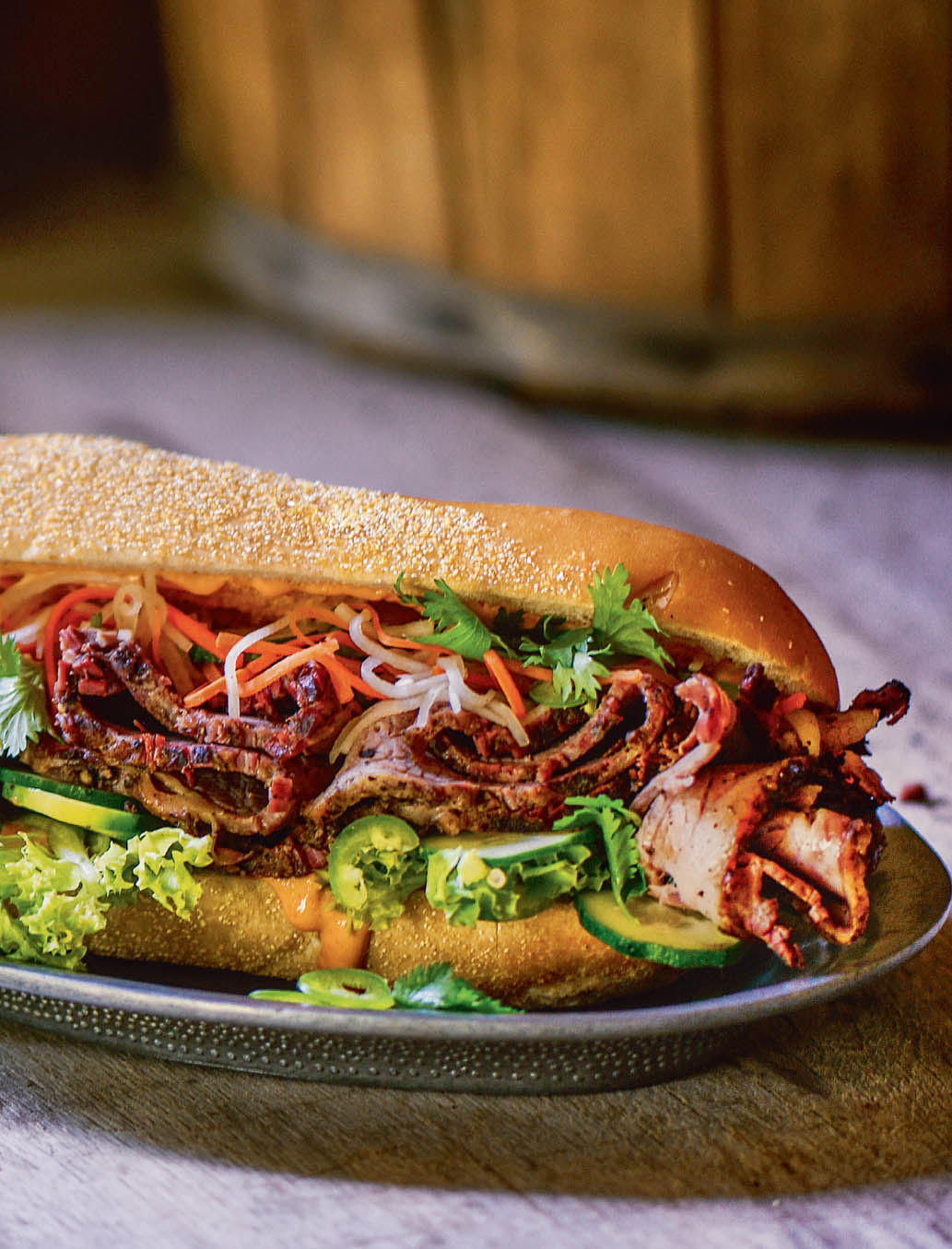

Chapter 8
Ever since an inveterate gambler, one John Montagu, had the idea to pile roast beef between bread slices (the better to lunch at the gaming table), the sandwich (Montagu’s title was the Earl of Sandwich) has been essential to human happiness. And wherever you find great sandwiches, you’re sure to find brisket. The deli would be a glum place without pastrami or corned beef on rye; the world in general would be poorer without the Reuben—that glorious melting pot sandwich of Swiss cheese, German sauerkraut, Russian dressing, and Jewish corned beef (doubled down here with pastrami). To these classics add cross-cultural mash-ups, such as the Texas French Dip (made with Camembert or Brie cheese and barbecued brisket), Southern “cheesesteak” (brisket lavished with homemade pimento cheese), and Vietnamese-style brisket banh mi. The “Smoky Joe”—a saucy chopped brisket sandwich—blows the traditional sloppy Joe off its bun. And speaking of buns, try the Korean-style brisket steamed bun from Hometown Bar-B-Que in Brooklyn.
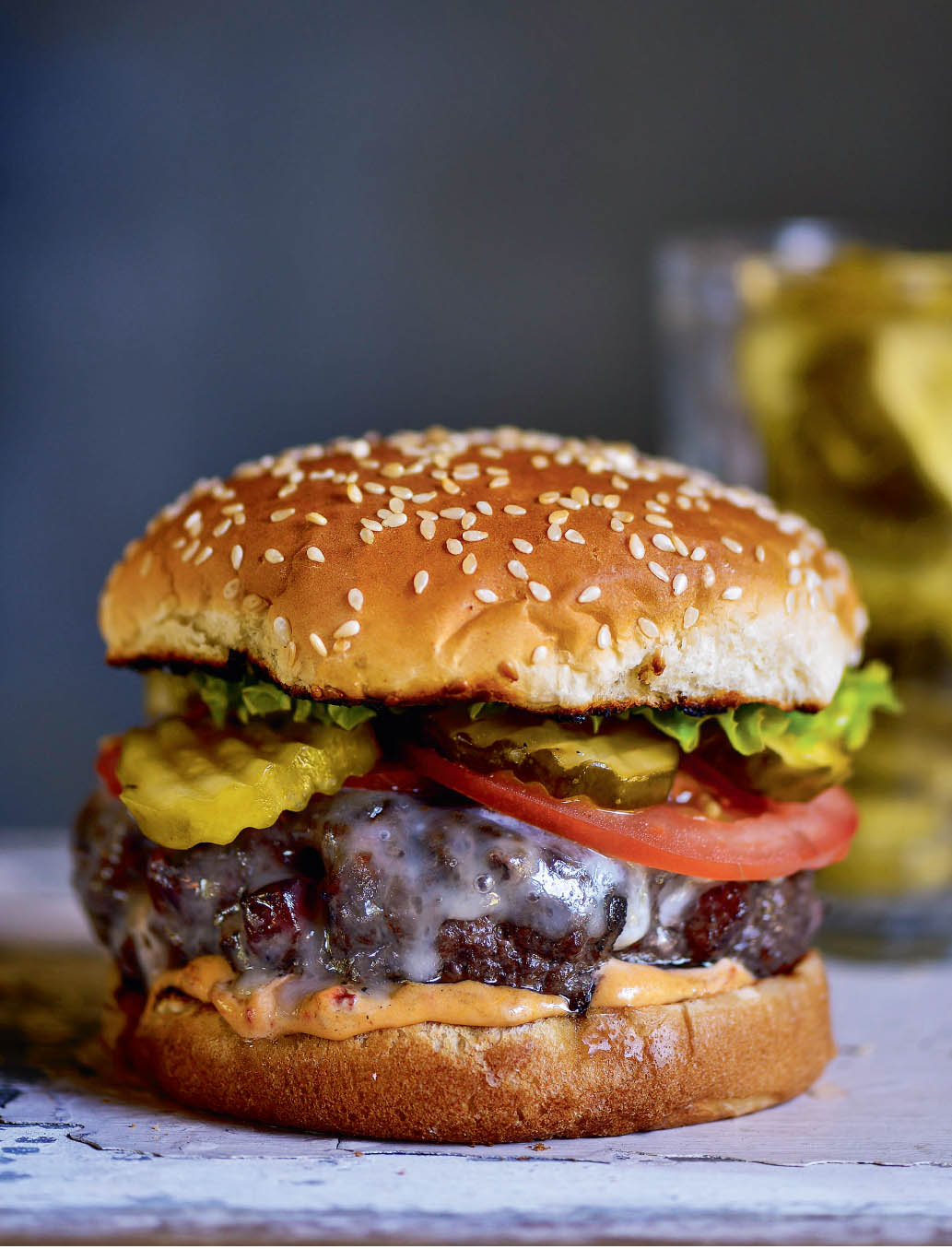
JAKE’S DOUBLE BRISKET CHEESEBURGERS
YIELD: Makes 4 burgers
METHOD: Direct grilling
PREP TIME: 10 minutes
COOKING TIME: 6 to 8 minutes
HEAT SOURCE: Grill
YOU’LL ALSO NEED: A grill spatula (but no pressing) and a digital instant-read thermometer
WHAT ELSE: You’ll likely need to special-order ground brisket from your local butcher shop. Ask them to grind it from a section containing some of the fattier point. Alternatively, grind your own (you must use a meat grinder, not a food processor). You’re looking for a fat content of around 20 percent. And ideally, you’ll grill these over wood or a wood-enhanced fire.
The double brisket bratwurst created by sausage master Jake Klein is one of the world wonders of wurst—succulent, spicy, and smoky, with just the right snap to the casing. Nepotism alert: Jake Klein is my stepson, but if you don’t believe me, here’s how New York Times restaurant critic Pete Wells described it: “a phenomenal piece of barbecue, packing more smoke into a sausage than I’d thought possible.” That’s the good news. The bad news is that the formula is a trade secret, and Jake isn’t talking—even to me. He will provide the next best thing—the recipe for his double brisket burgers—made with a similar filling. In addition to being exceedingly tasty, it’s one of the rare briskets you can direct grill.
INGREDIENTS
For the burgers
1½ pounds ground brisket (cut from the fatty point section—you want about 20 percent fat), well chilled
½ pound of your favorite barbecued brisket (see here), chilled and chopped
Vegetable oil, for oiling the grill grate
Coarse sea salt and freshly ground black pepper
4 thin slices sharp provolone cheese (optional)
For serving
4 sesame hamburger buns or pretzel rolls, cut in half
2 tablespoons melted butter or Brisket Butter
Optional embellishments
Lettuce leaves—for example, Boston or butter lettuce
Tomato slices
Dill or sweet pickle chips
Chipotle Mayonnaise or your favorite condiments (ketchup, mustard, relish, and so on), for serving
1. Place the ground brisket and chopped cooked brisket in a large bowl and mix with a wooden spoon. Moisten your hands with cold water and form the mixture into four equal patties, each ¾ inch thick. Dimple the center slightly with your thumb (burgers rise more in the center as they cook, so this will help them retain a uniform thickness). Line a plate with plastic wrap, set the burgers on it, and chill in the refrigerator for 1 hour.
2. Set up your grill for direct grilling (see here) and heat to high. Brush or scrape the grill grate clean and oil it well.
3. Generously season the burgers on both sides with salt and pepper. Arrange on the grate and grill until the bottoms are sizzling and browned, 3 to 4 minutes. Give each a quarter turn after 1½ minutes so they grill evenly. Flip the burgers and lay the provolone slices (if using) on top. Close the grill lid and continue grilling until the cheese is melted and the burgers are cooked to taste, 3 to 4 minutes more. The USDA recommends an internal temperature of 160°F (medium to medium-well). Cook as your conscience and common sense dictate. Insert the probe of an instant-read thermometer through the side of the burger to check it.
4. Meanwhile, brush the cut sides of the buns with butter. Toast the buns, cut sides down, on the grill, about 30 seconds.
5. To assemble the burgers, line the bottom of each toasted bun with a lettuce leaf, if using (this keeps the burger juices from making the bun soggy). Add the burger and any of the remaining embellishments, including Chipotle Mayonnaise or your favorite condiments. Add the top bun and dig in.
YIELD: Makes 2 sandwiches (can be multiplied as desired)
PREP TIME: 10 minutes
COOKING TIME: 5 minutes
HEAT SOURCE: Stove or contact grill
YOU’LL ALSO NEED: A contact grill, sandwich grill, or panini press, or a skillet, griddle, or plancha with a grill press
WHAT ELSE: With a sandwich this simple, perfection lies in the details. For the ultimate Reuben, you’d use my Classic Corned Beef and Old School or New School Pastrami—thinly sliced. Otherwise, order freshly and thinly sliced meats from your favorite delicatessen. For cheese, I recommend cave-aged Gruyère (it has a lot more bite than generic Swiss cheese). The sauerkraut should be artisanal (use the homemade version found here or source kraut at your local farmers’ market). And while you’re at it, make your own Russian dressing. And, of course, you’ll griddle the rye bread with real butter to give it the requisite richness and crunch.
Invented in 1914, the Reuben has become one of the great American sandwiches. Its melting pot immigrant roots are obvious: Irish American corned beef, German sauerkraut, Swiss cheese, Russian dressing. It took a New York Jewish delicatessen owner—one Arnold Reuben—to put them together. Tradition calls for corned beef, but in recent years I’ve taken to making my Reubens with pastrami—a twist that adds blasts of garlic, pepper, and wood smoke. The following sandwich uses both meats—the contrast of salty and sweet (cured meats and Russian dressing) and crunchy and gooey (the crisp sauerkraut and melted cheese) remains as wondrous as ever.
INGREDIENTS
4 slices dark or marbled rye bread
2 tablespoons salted butter, at room temperature
6 tablespoons Russian Dressing (recipe follows)
3 to 4 ounces corned beef (see What Else), sliced paper-thin
3 to 4 ounces pastrami beef (see What Else), sliced paper-thin
⅔ cup well-drained sauerkraut (see What Else)
4 ounces thinly sliced Gruyère cheese
1. Slather two rye bread slices with half the butter and place buttered side down on a plate. Spread the tops of these slices with half the Russian Dressing. Lay the corned beef and pastrami on top of the dressing, followed by the sauerkraut and Gruyère.
2. Spread the remaining two read slices with the remaining Russian Dressing. Place them dressing side down on the sandwiches and spread the tops with the remaining butter.
3. If using a contact grill, preheat it. Grill the sandwiches until the bread crisps and browns, the cheese melts, and the meats are hot, 3 to 5 minutes. Alternatively, if using a skillet, griddle, or plancha, heat it over medium-high heat. Add the sandwiches and place a grill press on top. Cook until the bread crisps and browns, the cheese melts, and the meats are hot, 3 to 5 minutes per side, carefully turning with a spatula.
4. Cut each sandwich in half on the diagonal and serve at once.
RUSSIAN DRESSING
Yield: Makes 1⅓ cup
Russian dressing is easy to make from scratch at home, requiring only four ingredients (one of which is pepper). Another bonus: There’s no added sugar.
INGREDIENTS
⅔ cup mayonnaise (preferably Hellmann’s or Best Foods)
¼ cup chili sauce (such as Heinz)
¼ cup sweet pickle relish
Freshly ground black pepper
Combine the mayonnaise, chili sauce, relish, and black pepper in a bowl and stir to mix. Russian Dressing will keep, in a sealed jar in the refrigerator, for at least 3 days.
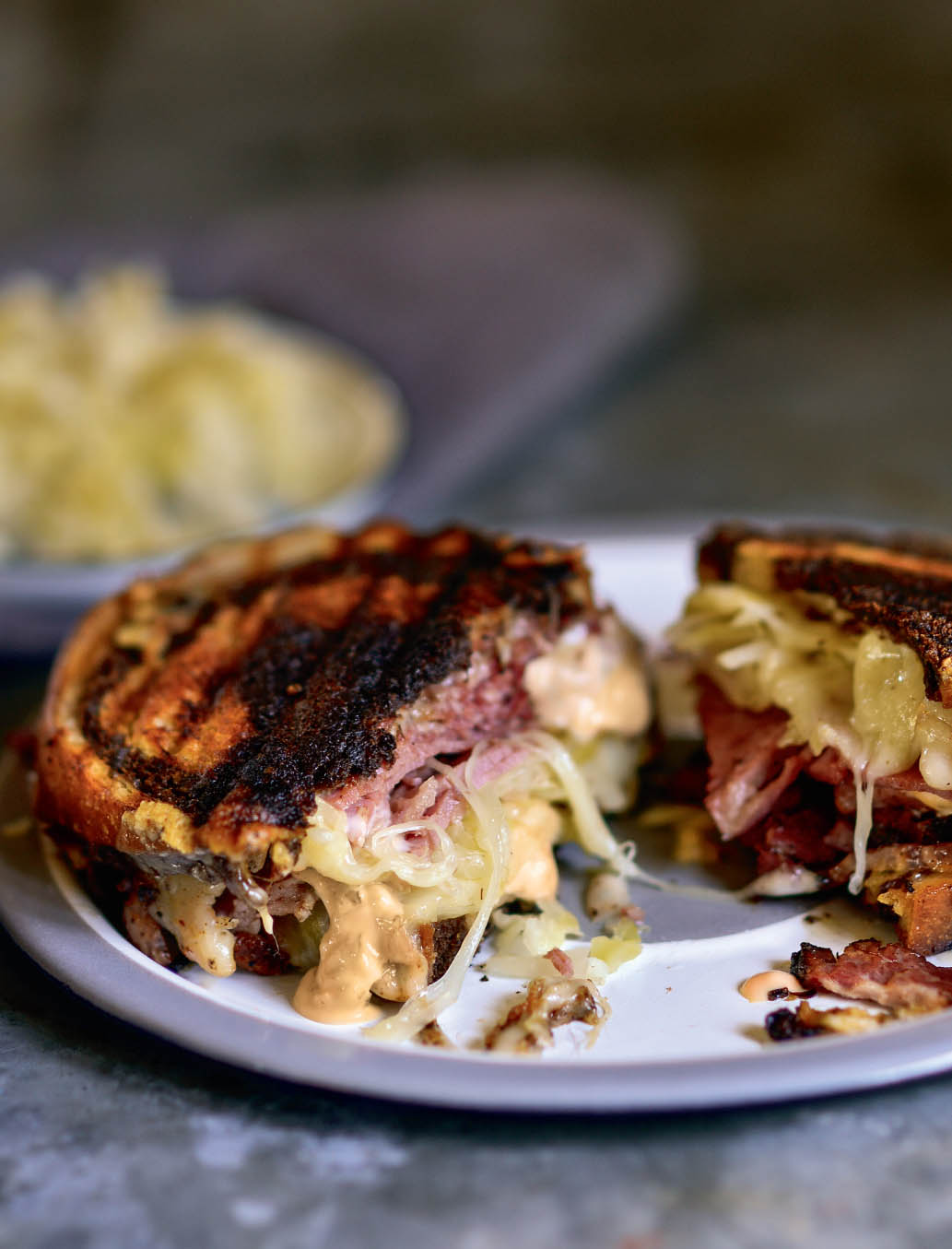
SOUTHERN “CHEESESTEAK”
YIELD: Makes 2 sandwiches (can be multiplied as desired)
METHOD: Pan-frying
PREP TIME: 30 minutes
COOKING TIME: 5 minutes for the poblano pan-fry
Heat source: Stove
YOU’LL ALSO NEED: A food processor with grating disk and chopping blade (for pimento cheese)
WHAT ELSE: A fully loaded Philly cheesesteak comes with sautéed onions, mushrooms, and peppers. I’ve pared the toppings back to keep the focus on the brisket. Sure, you could buy prepared pimento cheese. But it’s easy to make from scratch and a lot more flavorful.
Imagine if the cheesesteak had originated in Charleston or Dallas, not Philadelphia. You’d top it with spicy pimento cheese in place of Cheez Whiz or provolone. You might light it up with poblanos instead of bell peppers. Above all, you’d make it with barbecued brisket in place of steak so cheap and tough that you have to shave it paper-thin to make it palatable. Well, feast your imagination on this Southern cheesesteak.
INGREDIENTS
For the poblano pan-fry
2 tablespoons extra virgin olive oil
1 large poblano, stemmed, seeded, and cut into matchstick slivers
1 shallot, thinly sliced crosswise
¼ cup chopped fresh cilantro
For assembly
2 hoagie rolls
Chipotle Mayonnaise, regular mayonnaise (preferably Hellmann’s or Best Foods), or the condiment of your choice
½ pound hot barbecued brisket (see here), sliced ¼ inch thick and warm (see Note)
½ cup Made-from-Scratch Pimento Cheese, or to taste (recipe follows)
1. Heat the olive oil in a frying pan over medium-high heat. Add the poblano, shallot, and cilantro and fry until the poblano and shallot are browned at the edges and tender, 3 to 5 minutes. Keep warm.
2. Cut the hoagie rolls almost in half through the sides, opening each like a book. Slather the inside of each with Chipotle Mayonnaise or the condiment of your choice. Add the sliced brisket and poblano pan-fry. Spoon the pimento cheese on top and dig in.
Note: There are a couple of ways to reheat brisket: Lightly fry the slices in melted butter or olive oil in a skillet over medium-high heat. Or wrap the brisket in foil and warm it in a 250°F oven.
MADE-FROM-SCRATCH PIMENTO CHEESE
Yield: Makes 1 cup
Pimento cheese is one of the glories of Southern cuisine—sharp cheddar, tangy Tabasco, creamy mayonnaise, and sweet pimentos pureed to a piquant spread that utterly transforms the common brisket sandwich.
INGREDIENTS
8 ounces aged orange cheddar cheese, chilled
1 jar (2 ounces) pimentos, drained and blotted dry
¼ cup mayonnaise (preferably Hellmann’s or Best Foods)
2 tablespoons Dijon mustard
1 tablespoon Tabasco sauce or your favorite hot sauce, or to taste
Sea salt and freshly ground black pepper
1. Coarsely grate the cheese in a food processor. (A grating disk works best for this.)
2. Using the chopping blade, work in the pimentos, mayonnaise, mustard, and hot sauce, running the processor in short bursts. Do not overprocess. The mixture should be coarse, not smooth. Add salt and pepper to taste. The mixture should be highly seasoned.
Made-from-Scratch Pimento Cheese will keep, in a sealed container in the refrigerator, for at least 3 days.
SMOKY JOE
(THE BRISKET SLOPPY JOE SANDWICH)
YIELD: Serves 4
METHOD: Sautéing
PREP TIME: 20 minutes
COOKING TIME: 20 minutes
HEAT SOURCE: Stove; grill, panini press, or contact grill for the buns
WHAT ELSE: Traditional sloppy Joes come on soft industrial hamburger buns. You’re going to up the ante by using brioche rolls that you butter and grill like garlic bread. For that matter, you could also serve the Smoky Joe on 1-inch-thick slices of grilled garlic French bread or Lone Star Toast.
Remember the sloppy Joe? That sweet, saucy, hamburger-based loose-meat stew ladled onto squishy hamburger buns by the cafeteria ladies at your school? Hardly the stuff of epicurean panegyric. But suppose you replaced the ground beef with chopped smoked brisket? Added barbecue sauce instead of ketchup and cut way back on the sugar? Fortified the mixture with poblano and jalapeño chiles instead of bell peppers? You’d wind up with something you might call the brisket version of pulled pork. Your tailgating buddies will be very glad you thought of it.
INGREDIENTS
For the brisket mixture
2 tablespoons butter or extra virgin olive oil
3 to 4 large shallots, finely chopped (about ¾ cup)
1 poblano chile, stemmed, seeded, and finely chopped
2 jalapeños, stemmed, seeded, and finely chopped (for spicier Smoky Joes, leave the seeds in)
¼ cup chopped fresh cilantro
1½ pounds barbecued brisket (see here), shredded or chopped
1 cup canned tomato sauce
½ cup of your favorite barbecue sauce (I’m partial to the Chipotle Molasses Barbecue Sauce)
2 tablespoons Worcestershire sauce
2 tablespoons brown sugar (optional)
Sea salt and freshly ground black pepper
For serving
4 tablespoons (½ stick) butter
1 clove garlic, minced
2 tablespoons chopped fresh cilantro or parsley
4 brioche buns, cut in half crosswise
Sweet pickle chips or dill pickle chips (optional)
1. Heat the butter or oil in a skillet. Add the shallots, poblano, jalapeños, and cilantro and cook over medium-high heat until sizzling and browned, 4 minutes.
2. Stir in the brisket and cook, stirring occasionally, until browned, 3 to 4 minutes. Stir in the tomato sauce, barbecue sauce, Worcestershire sauce, brown sugar (if you like your Smoky Joes sweet), and salt and pepper to taste. Simmer the mixture until thick and richly flavored, 10 minutes.
3. Meanwhile, make the garlic butter: Melt the butter in a small saucepan. Add the garlic, cilantro, and a pinch of salt and cook until the garlic is fragrant and golden, 2 minutes. Don’t let it burn. Brush the cut sides of the buns with the garlic butter.
4. Set up your grill for direct grilling (see here) and heat to high, or heat a contact grill or panini press. Grill the buns, cut sides down, until toasted, 30 seconds to 1 minute.
5. To serve, spoon the Smoky Joe mixture onto the toasted buns. Top with pickle chips, if desired, and dig in.
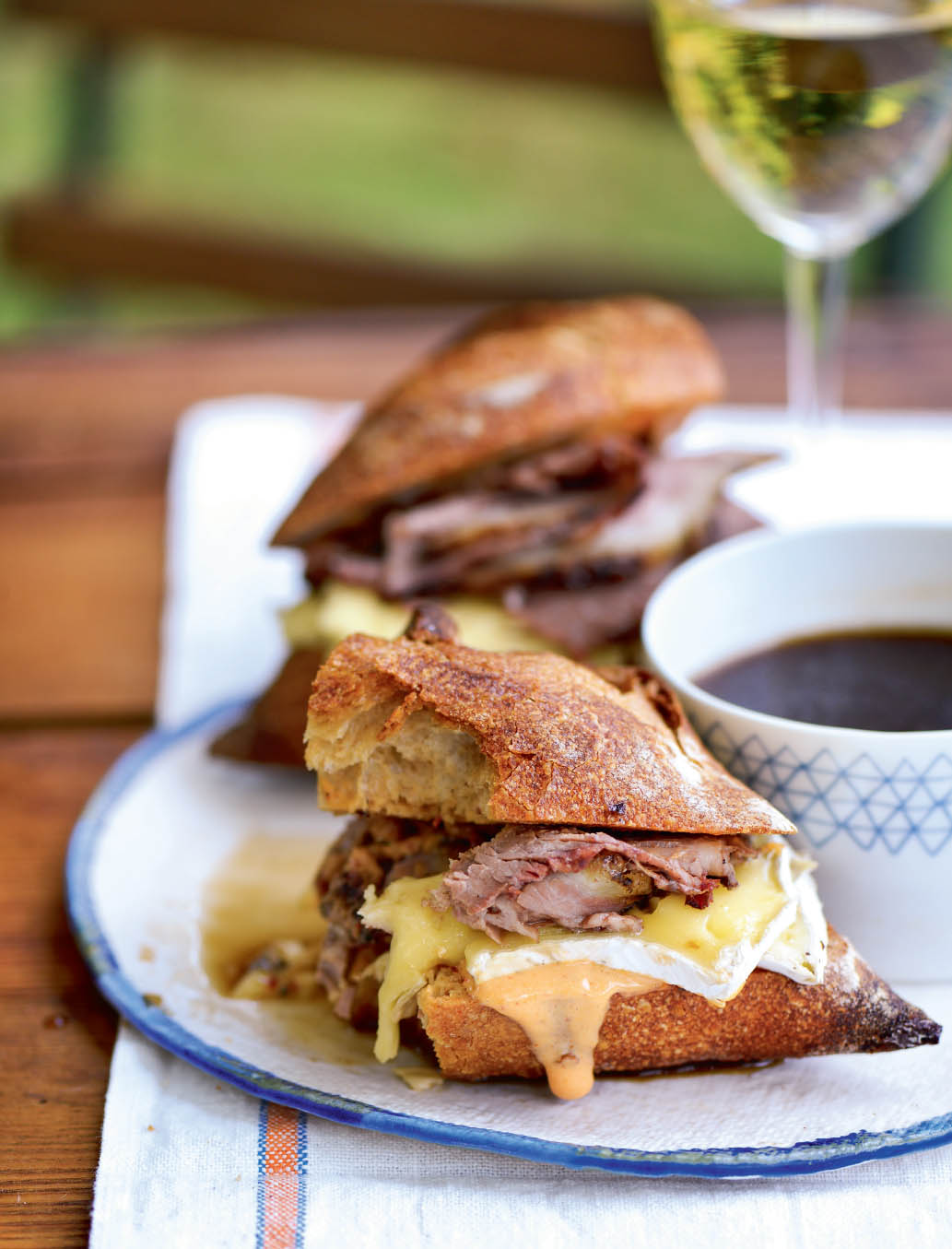
TEXAS FRENCH DIP SANDWICH
YIELD: Serves 2 (can be multiplied as desired)
METHOD: Boiling
PREP TIME: 15 minutes
COOKING TIME: 5 minutes
HEAT SOURCE: Stove
WHAT ELSE: In the best of all possible worlds, you’d dip the sandwich in homemade beef stock reinforced with brisket drippings. There are several options in this book: the Jewish Deli Brisket broth, for example; the Bollito Misto broth; or the Basic Brisket Broth. Alternatively, use a good commercial beef broth—preferably low-sodium. Note: Tradition calls for a soft French roll, but I prefer a crusty baguette.
Name notwithstanding, the French dip sandwich originated not in Paris or Lyon, but at a sandwich shop in Los Angeles. The year was 1918. The place: Philippe the Original (still in business on Alameda across from Union Station in downtown LA). The inventor, one Philippe Mathieu, was indeed a Frenchman, who, as legend has it, accidentally dropped a roll into a pan of roast beef drippings while preparing a sandwich for a local policeman. The cop ate it anyway and returned the next day to order another one. The “French dip” sandwich quickly became the house specialty and it remains so to this day. You’re about to give it a Texas twist by replacing the roast beef with—you guessed it—barbecued brisket. To reinforce the smoke flavor, I suggest a nontraditional condiment—Chipotle Mayonnaise. The cheese isn’t traditional, but I like the way it rounds out the sandwich. In keeping with Mathieu’s origins, I suggest Camembert or Brie.
INGREDIENTS
1 crusty baguette, cut in half crosswise, or 2 mini baguettes or soft French bread rolls
4 to 6 tablespoons Chipotle Mayonnaise
½ pound thinly sliced barbecued brisket (see here), at room temperature or warm (see Note)
6 ounces Camembert or Brie cheese (optional), at room temperature—it is very important to use cheese that isn’t cold
2 cups beef broth or stock (preferably homemade or low-sodium; see What Else)
2 tablespoons brisket drippings (optional)
Sea salt and freshly ground black pepper
1. Cut each piece of bread almost in half through one side and open it like a book. Spread the inside of each on the top and bottom with Chipotle Mayonnaise, and layer in the sliced brisket and cheese.
2. Meanwhile, bring the beef broth and brisket drippings, if using, to a boil in a saucepan over medium-high heat. Add salt and pepper to taste. The broth should be highly seasoned. Transfer the broth to two deep bowls.
3. Serve the sandwiches with bowls of piping-hot broth for dipping. When you get it right, the hot broth will heat the brisket and melt the cheese.
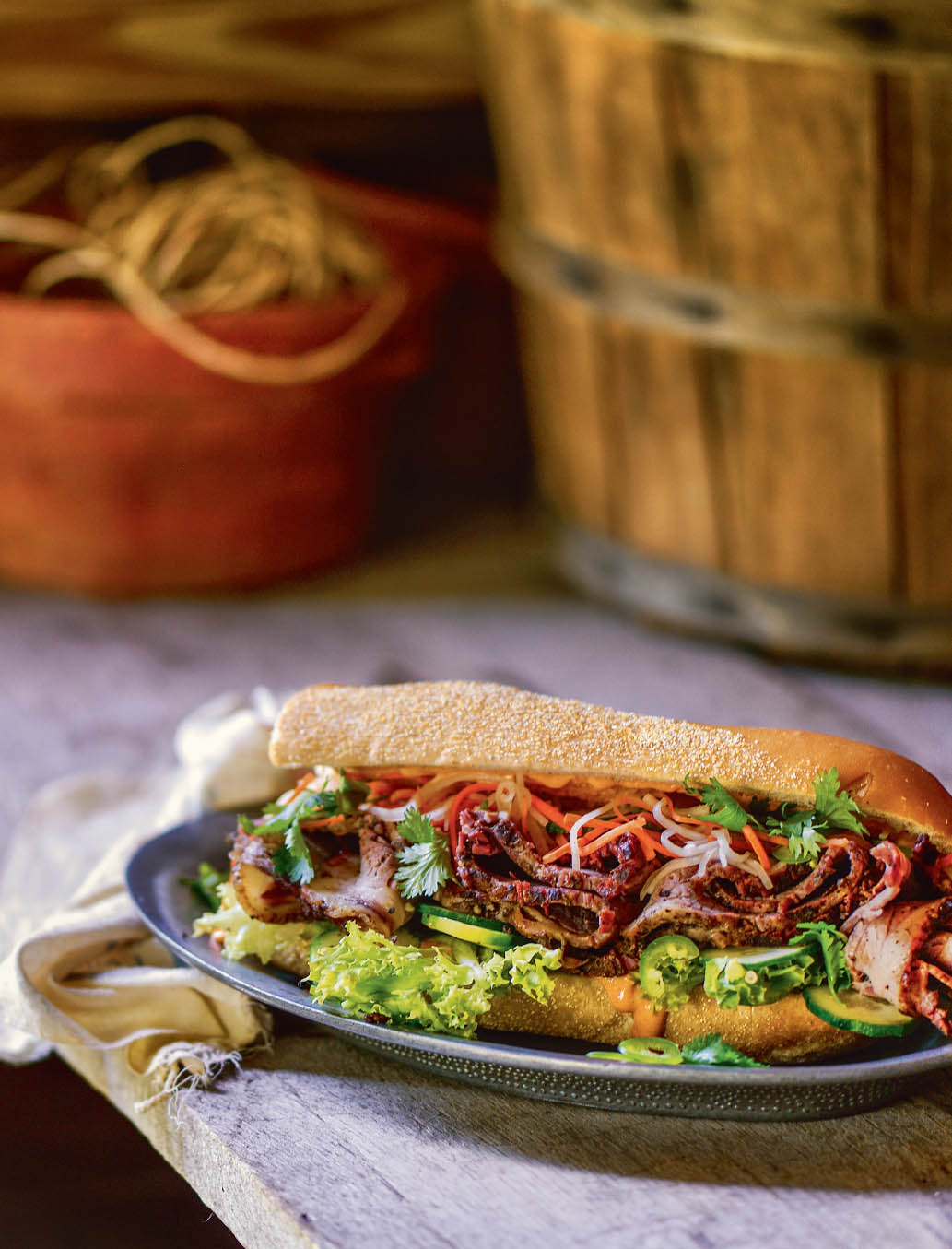
BRISKET BANH MI
YIELD: Serves 2 (can be multiplied as desired)
METHOD: Pickling for the slaw
PREP TIME: 20 minutes
COOKING TIME: 30 minutes for marinating the slaw
WHAT ELSE: This banh mi calls for barbecued brisket, but you could also use a braised brisket from chapter 4 (I suggest the Jewish Deli Brisket). For even more flavor, replace the sliced cucumber with the Korean Cucumber Salad.
Vietnam’s banh mi occupies a sacred place in the world’s sandwich pantheon—meaty pâté, crisp lettuce, and sweet-sour carrot and radish slaw, all piled onto a crusty baguette (the latter a legacy of the French, who occupied Vietnam for a century). And that’s before you add the fireworks of sliced chiles, fresh cilantro, and Sriracha Mayonnaise. In other words, it’s a kaleidoscope of aromas, textures, and tastes. The following banh mi was inspired by one of my favorite Los Angeles carry-outs, Gjelina Take Away, in Venice. They use braised brisket, but I’ve taken the smoky route with Texas-style barbecued brisket.
INGREDIENTS
For the Vietnamese slaw
2 carrots, trimmed, peeled, and cut into matchstick slivers
1 medium-size daikon radish (about 8 ounces), peeled and cut into matchstick slivers
½ teaspoon sea salt
3 tablespoons sugar
½ cup rice vinegar
1 tablespoon Asian fish sauce
2 allspice berries, lightly crushed
Freshly ground black pepper
To finish the sandwiches
1 large crusty baguette, cut in half crosswise, or 2 mini baguettes
4 to 6 tablespoons Sriracha Mayonnaise
1 head Boston lettuce, separated into leaves, washed, and spun dry
1 cucumber (preferably Kirby), thinly sliced
6 to 8 ounces your favorite barbecued brisket (see here), thinly sliced
8 sprigs fresh cilantro, washed and shaken dry
1 scallion, trimmed, white and green parts thinly sliced on a sharp diagonal
1 to 2 jalapeños, stemmed and sliced paper-thin (for milder banh mi, remove the seeds)
1. Make the Vietnamese slaw: Place the carrots and daikon in a mixing bowl and stir in the salt and sugar. Let the vegetables marinate for 5 minutes. Add the rice vinegar, fish sauce, allspice berries, and pepper, and stir until the sugar dissolves. Let the slaw marinate for at least 30 minutes or as long as overnight (cover and refrigerate until serving). Discard the allspice berries before serving.
2. Cut each piece of bread almost in half through one side and open like a book. Slather the insides of each piece with Sriracha Mayonnaise and line with lettuce and sliced cucumber. Pile on the brisket. Add the slaw with some of the juices, and cilantro, scallion, and sliced jalapeños. Close the sandwiches if you can and get ready for one of the best East-West flavor fusions on Planet Barbecue.
Sriracha Mayonnaise
Yield: Makes 1 cup
Sriracha Mayonnaise gives this banh mi the perfect dose of creaminess, piquancy, and spice. It’s pretty compelling slathered on brisket sandwiches of all stripes.
INGREDIENTS
¾ cup mayonnaise (preferably Hellmann’s or Best Foods)
3 tablespoons sriracha
½ teaspoon finely grated lime zest
1 tablespoon freshly squeezed lime juice
Combine the ingredients in a bowl and whisk to mix.
Sriracha Mayonnaise will keep, in a sealed container in the refrigerator, for at least 3 days.
BRISKET WHISPERER—BILLY DURNEY

Billy Durney remembers the exact moment he took barbecue as the true religion: “I walked into Louie Mueller Barbecue in Taylor, Texas. One bite of brisket and I knew—this is who I want to be and this will be my life’s work.”
So the security expert (a former bodyguard for Oscar-nominated actresses and Grammy Award–winning musicians) found a century-old former woodworker’s warehouse in Red Hook, Brooklyn—vacant for decades—and turned it into a cavernous dining room fitted with timbers and paneling from an antique barn. He installed an Ole Hickory carousel smoker in the back corner and parked an oversize Lang barrel smoker by the front door. He perfected his brisket recipe and hired local bands for entertainment.
Then Hurricane Sandy struck, flooding his dining room with 6 feet of water. The restoration took more than a year, and Hometown formally opened on September 12, 2013. By the end of the week, they had waiting lines and were selling out of meat.
Like most of the new wave pit masters, Durney takes an ecumenical approach, cooking his ribs St. Louis–style and his pork shoulders in the manner of North Carolina. He powers the house hot sauce with Thai sriracha. He serves barbecued lamb belly Vietnamese banh mi–style—with house pickles on a crusty baguette.
But the heart and soul of Hometown is the brisket. Coal-black slabs of steaming meat so smoky it smells like a fireplace and so moist it squirts when you cut into it. Tender? Let’s just say you can cut it with the side of a fork.
The secret? “We start with Niman Ranch natural briskets and use only two seasonings: salt and pepper,” explains Durney. “We burn white oak in our pits. We cook hotter than most restaurants—275°F—and we smoke for up to 15 hours.”
Of course, great brisket is made not just with seasonings and wood smoke, but with the dozens of personal touches developed over time and experience. Durney cooks his slabs on rectangles of perforated cardboard—a way to protect the lean meat of the flat from drying out or burning on the hot grate. (See box.)
“Resting the meat is one of the most important things you can do to ensure moist, tender brisket,” says Durney. Hometown’s rests for 5 hours in a professional meat warmer called an Alto-Shaam. At home, Durney recommends a minimum 2-hour rest in an insulated cooler.
So how do you know when the brisket is ready? “We never use a meat thermometer,” explains Durney. “It’s all done by touch and feel. Poke each slab (wear heatproof gloves) and watch how it jiggles. Imagine Jell-O comprised of animal protein and beef fat. That’s how a properly cooked brisket should feel.”
BRISKET STEAMED BUNS
YIELD: Makes 12 buns, enough to serve 4 to 6
METHOD: Steaming (for the buns)
PREP TIME: 20 minutes
COOKING TIME: 10 minutes
HEAT SOURCE: Stove
YOU’LL ALSO NEED: A bamboo steamer; parchment paper; a wok or pot
WHAT ELSE: The easiest way to source steamed buns is frozen from an Asian market. While you’re at it, buy some gochujang (Korean chile paste). Sambal oelek is a fiery chili sauce from Indonesia—sriracha will work in a pinch. Note: The traditional way to warm the buns is in a Chinese bamboo steamer over a wok. Line the steamer with a circle of parchment paper to keep the buns from sticking.
In Texas (and Brooklyn) the traditional bread served with brisket is a soft puffy white industrial loaf, like Wonder Bread. (An oddly ignominious accompaniment, I’ve always thought, for this noble slab of steer.) The Asian equivalent is the steamed bun, which is equally soft and puffy, but with more chew and cachet. Billy Durney of Hometown Bar-B-Que in Brooklyn (see here) normally packs steamed buns with barbecued lamb belly or short ribs. He created the following brisket steamed bun for The Brisket Chronicles. Think smoky beef, sweet-salty barbecue sauce, and pickled cucumbers for crunch. In other words, think heaven on earth on a steamed bun.
INGREDIENTS
12 Asian-style steamed buns, thawed if frozen
1½ pounds your favorite barbecued brisket (see here), thinly sliced and warm (see Note)
1 batch Korean Cucumber Salad) or 2 Kirby cucumbers, thinly sliced
4 scallions, trimmed, white and green parts thinly sliced on a sharp diagonal
3 tablespoons toasted sesame seeds (see What Else), for serving
Korean Barbecue Sauce (recipe follows), for serving
Sriracha or sambal oelek, for serving (optional; see What Else)
1. Set up a bamboo steamer lined with parchment paper over a wok or pot (see here). Add the buns and steam until hot, 5 to 10 minutes.
2. Open each bun and add a slice of brisket, a spoonful of cucumber salad (or a couple of cucumber slices), scallions, sesame seeds, and a generous dollop of Korean Barbecue Sauce. If you like spice, add a drizzle of sriracha or a smear of sambal oelek.
3. Enjoy immediately, while the buns are piping hot.
Yield: Makes 2 cups
I first wrote about Korean barbecue more than 20 years ago, in The Barbecue! Bible. But it took a Los Angeles food truck operator turned restaurateur—Roy Choi, creator of the Kogi BBQ taco—to make it a national food fetish. Like its Kansas City counterpart, Korean barbecue plays sweet against salty against spicy (in this case, brown sugar, soy sauce, and ginger). The fireworks come from a Korean chile paste called gochujang. If you like a pronounced umami flavor and tongue-tingling heat, this Korean barbecue sauce is your new best friend.
INGREDIENTS
1 tablespoon toasted (dark) sesame oil
A ½-inch piece fresh ginger, peeled and minced
1 clove garlic, peeled and minced
¼ cup rice vinegar, plus extra as needed
½ cup tamari soy sauce, plus extra as needed
½ cup brown sugar, preferably dark, plus extra as needed
⅓ cup gochujang (Korean chile paste)
1 teaspoon freshly ground black pepper
Heat the sesame oil in a small saucepan. Add the ginger and garlic and cook over medium heat until lightly browned, 2 minutes. Stir in the rice vinegar and bring to a boil. Stir in the tamari, ⅓ cup water, brown sugar, gochujang, and black pepper and bring to a boil. Gently simmer the sauce, whisking from time to time, until richly flavored, 5 to 8 minutes. If sauce is too thick, thin it with a little water. Correct the seasoning, adding more tamari, vinegar, or sugar to taste. The sauce should be a little sweet and a little salty with just a touch of acidity.
Korean Barbecue Sauce will keep, in a sealed container in the refrigerator, for at least 1 week.